
THIS week should have been the last chance to see York tragic-comic Pop artist and writer Harland Miller’s largest ever solo exhibition in his home city.
Four years in the talking and curating, Harland Miller: York, So Good They Named It Once was due to run at York Art Gallery from February 21 to May 31 2020, but then Covid-19 determined that the shutters should come down in the latter pages of March’s diary.
All artistic eyes may now be on Grayson Perry’s Channel 4 Monday night series Grayson’s Art Club, but here is one last opportunity to hear Miller’s tale, if you alas never saw the show featuring his best-known series, the Penguin Book Covers and the Pelican Bad Weather Paintings.
These works directly refer to the 56-year-old artist’s relationship with York, the city where he was born and grew up before moving to London, as well as making wider reference to the culture and geography of Yorkshire as a whole.
The titles are all sardonic statements on life: for example, York, So Good They Named It Once; Whitby – The Self Catering Years; Rags to Polyester – My Story and Incurable Romantic Seeks Dirty Filthy Whore.
In these works, he marries aspects of Pop Art, abstraction and figurative painting with a writer’s love of text, using his own phrases, some humorous and absurd, others marked by a lush melancholia.
In addition to the dust-jacket paintings, Miller was showing works from his recent Letter Painting series: canvasses made up of overlaid letters to form short words or acronyms in a format inspired by the illuminated letters of medieval manuscripts.
“I wanted to go as far the other way as possible and use just one word, one short word at that, and see if that word would convey as much as a whole sentence,” he says. “I hoped the answer to this would be ‘yes’. In fact that was one of the first words I painted. YES.”
Significantly, Harland has not done a NO: testament to all that positivity the new works exude.
“If you’re wondering why I’m wearing dark glasses inside in February,” he said at the launch, “It’s because these works are so bright!”
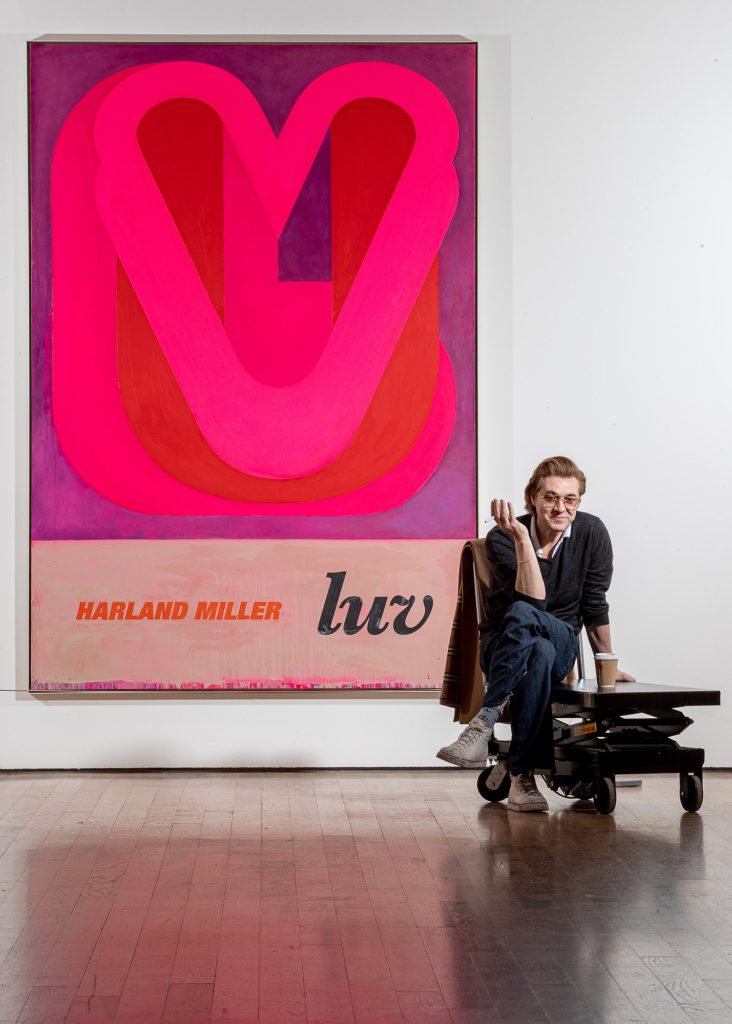
Here Harland Miller answers a series of questions on York, art and more besides.
What do you recall of growing up in Yorkshire?
“Well…for me…looking back on it, it seems like it was great! Idyllic even. But can it have been? Really? I dunno. I understand nostalgia – the way that works, because it’s one of the main themes in my own work – so, when I look back, I do try not to get caught up in it. I think it’s just inevitable that you do, though.
“I mean I think its counter-intuitive to reminisce about the bad times…isn’t it? I think the key phrase is ‘growing up’ because – yes, there were definitely things happening that were not great and must have worried my mum and dad… like, say, the power cuts for instance
“But as a kid – growing up I only remember the [Three Day Week] black-outs as being great! I even looked forwards to them and was sad when the power came back on and showed up all the cracks.
“I think it was because, y’know, mainly, it was a time when the family were all together. I was the youngest of three. My brother Baz was ten years older (still is), so when I was like eight, he was 18 and out on his motorbike with his gang of biker mates called The Ton Up Gang.
“The Ton was slang for doing 100mph and back in those days wearing a helmet was not yet compulsory… so pretty stressful for my mum, I think.
“My sister Helen, she was five years older than me (and sadly died at 46, so is now not still five years older – in fact I’m now ten years older than she will ever be – but in my mind she is still my big sister, just as she was when she was 13 and seemed like quite the grown-up, going to discos and the like).
“The Bop, I recall, in New Earswick was one such spot. And the Cats Whiskers up Fulford Road way. Such evocative names. I used to think, ‘Wow, Cats Whiskers! The Bop…Thee Bop! Wow! Must be so wild!”
“Maybe it was. I never went. I was too young to even hang round street corners then. So, I’d be in watching telly. Watching one of the three channels, one of which was BBC2, which didn’t ever seem to really broadcast anything apart from the test card.
“A young girl with a toy clown, I think. She’ll be getting on now, I imagine, that girl. But a little like my sister, she’s frozen in time – not just at that age but frozen in an era.
“Anyway, the point is that as a family we were all doing different things, and so I remember the ‘black-out’ bringing us all together round the kitchen table, playing these never-ending games of Monopoly by candlelight.
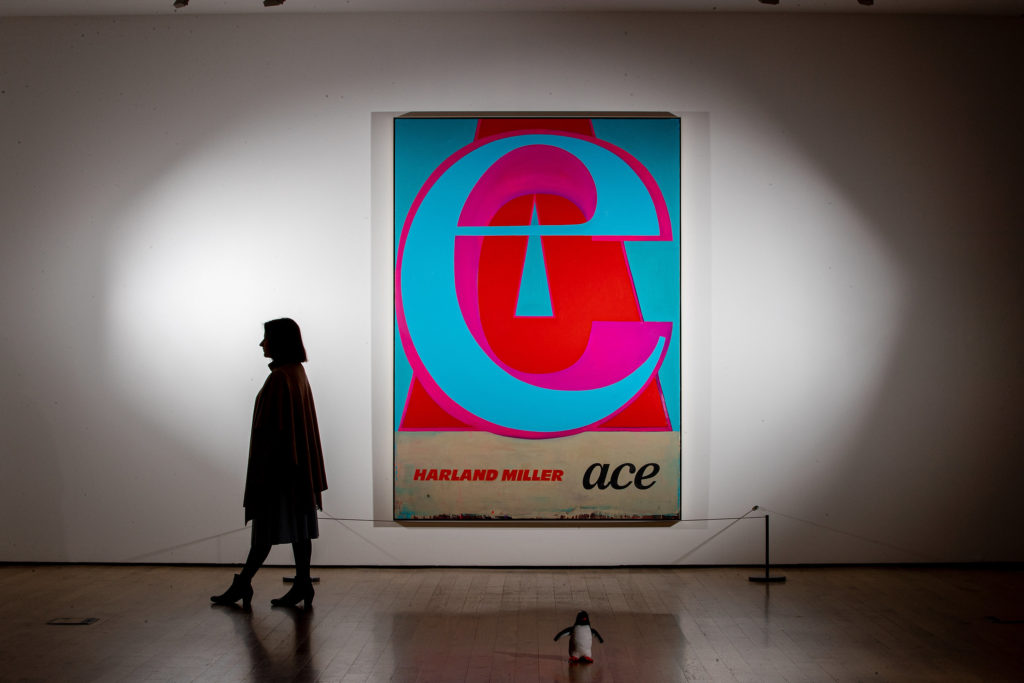
“I loved that but, like I say, that was my experience of it. If that were happening now, I’d spend the whole black-out thinking, ‘Where is this heading?’ and my younger self might be in a bad mood because he couldn’t charge his phone.
“There were unadulterated good times too though, like ‘Factory Fortnight’. My dad worked at Rowntrees on Black Magic and in the summer we would go to Scarborough for a week and take a chalet on the front. That really was magic.
“I feel so sad when I go back and see some of those chalets all boarded up or vandalised – I mean who’d vandalise a chalet? How tough do you have to be to vandalise a chalet? Go and vandalise the offices of the person who decided to concrete over one of the best Art Deco pools I’ve ever seen on the South Bay – that was a criminal act! It’s now a roller-skating rink and I’ve never seen anyone on there roller skating.
“Anyway, apart from that, it’s hard to summarise a childhood in a few words but if pushed, I’d say – on very careful consideration and without bias – Yorkshire was the best place to grow up in the solar system!”
What are your memories of your early life as an artist?
“It began when I was at school. I was in a kind of remedial class called Peanuts and the aim was just to get through it. There were only two of us in it and we both liked and had some aptitude for art, so the school at some level decided to make every lesson an art lesson.
“But because there had to be a practical application to everything, I was asked to turn my talents to making some ‘Keep Our School Tidy’ posters. This was the first commission I ever had and led to many more
“After the posters were put up all around school, they proved a big hit and the hardest kid at the school asked me…asked me! Ha!…told me he wanted me to paint ‘Shakin’ Stevens’ on his denim jacket, I did. No choice really.
“That was a big hit too and from that I got a lot more commissions, not just from Shaky fans but Mods, Rockers, Punks, Soulies (those into Northern Soul) and guys into CB Radio (these were all guys as well – no girls into CB for some reason) and many more types besides.
“The prices were five quid for a denim jacket; more for a leather. Tenner for a lid. £12 for a full lid. Pretty soon I was making more than the teachers and I saw that you could do the thing that everyone said you could not – which was make a living as an artist.”
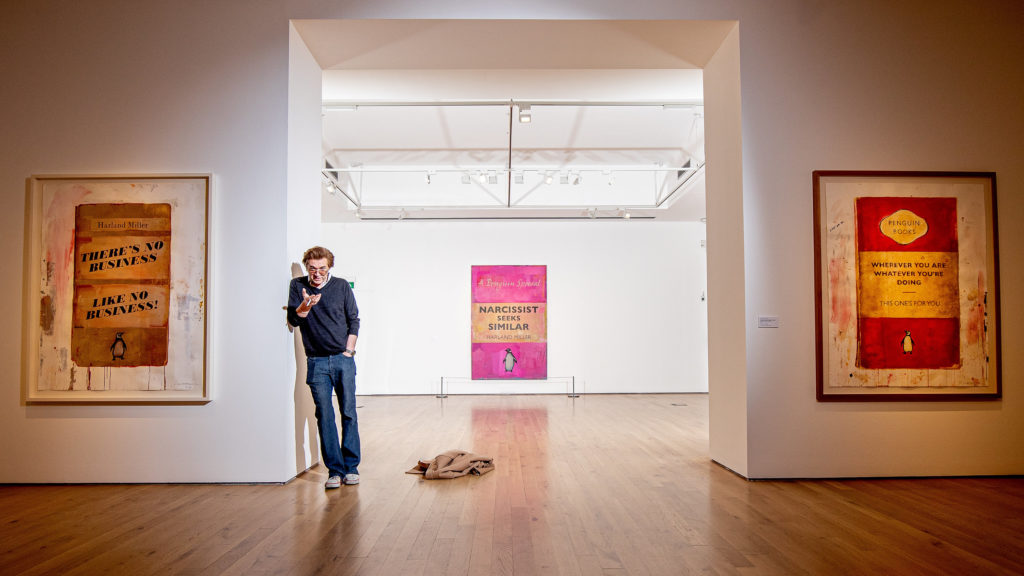
How have York and Yorkshire influenced your work?
“I could best describe this in a way by talking, not about my art, but another artist’s work who’s also from Yorkshire: David Hockney. When Hockney was in England, he made paintings about Typhoo Tea and when he arrived in LA [Los Angeles], he was amazed and enthralled – if they are not the same thing – to see that people had swimming pools in their back gardens.
“It was as commonplace a thing to them as his mother’s back yard was to him. Consequently, because they were commonplace, nobody had ever thought about painting the pools under their noses, so to speak!
“But it took a guy coming from Yorkshire to say, ‘Wow, I’m gonna paint this…this isn’t real…I must be dreaming’ and in point of fact, there is that surreal quality to those works, I think.
“I suppose I’m presenting that old cliche of ‘taking the Yorkshireman out of Yorkshire’. How’s it go? Y’know what I mean though? You can take the Yorkshireman out of Yorkshire.
“Also, my dad Ned, was something of a self-styled Communist. I remember waking past a restaurant with him and him looking in and saying, ‘Some of these fellas think nothing about having a glass of wine’.
“I recall thinking to myself, ‘Yeah…I’d like to think nothing about having a glass of wine too, instead of listening to you talking about central planning’, and in the spirit of rebellion, I told him I was moving to London.
‘What you gonna do there?’, he said. “It’s a pound for a cup of tea!” I replied that I was quite done with tea and all that and was gonna be living it up…on wine!”
Exit Yorkshire, enter Chelsea School of Art. What happened?
“When I got to London, it was borne in on me – almost immediately – not just how much I missed tea, but just exactly who I was. Suffice to say, if I’d stayed in Yorkshire, I don’t think I would have made the Bad Weather Paintings, which are many things…many things… but high among those things, they are clearly celebratory.
“They are satire too, sure, but I am – I’ve been told – unusual in that I like bad weather, within reason of course.
“A while back a doctor told me ‘one bit of good news’ was my body stored vitamin D to an unusual degree, so I can go for a long time without biologically missing the sun…so I guess that could account for being immune to drizzle.
“And, if it’s not stretching it too much to say it’s there, is also that sense of identity with Yorkshire. We could call it ‘Vitamin Y’ maybe, something I store and carry around with me.
“Of course, I need to see the sun every now and then and I need to come back to Yorkshire intermittently too – though actually I come back a fair bit. Most of my family are still here.”
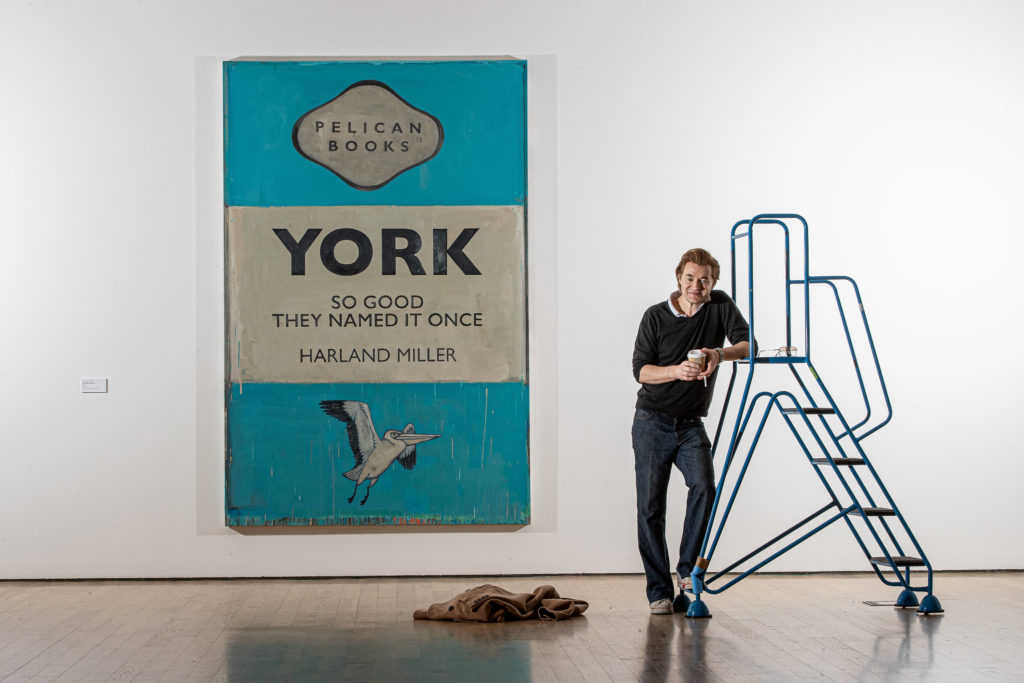
How and why do you use text so prominently in your work?
“I can explain that best in the series from which the York painting [York, So Good They Named It Once] comes because, in this series, more than the other book paintings, I’ve tried to paint them in a way that evokes the subject which is suggested in the title.
“With the Bad Weather theme of course that style pretty much suggests itself and the properties of paint can be handled to evoke the sense of rain running down window panes, heavy sea, heavy cloud, indeterminable drizzle.
“Artists often talk about ‘light’ and they follow the light to St Ives or Florence or somewhere, but these paintings are the opposite of that, I think. They are more about, I don’t want to say the dark internal stuff, but can I say that anyway? Maybe I actually mean introspection.
“And maybe that’s maybe why people have this personal connection to the work, because it provides a moment of introspection.
“Humour also can break a form of tension that arises when looking at a work of art in a formal space. And this is important, this laughter thing, because after that tension is broken, there is a freedom behind it, I think, and that happens very rarely. Indeed, most artists would be pretty affronted if you laughed at their work.
“People used to write me and ask me what my work meant: this was when it was abstract, and actually they used to ask what the hell it meant, but since I’ve been making work in which there is text – words, a suggested narrative – people write me and tell me what my work means to them!
“This is great because it obviously saves me the bother, but moreover, these stories are often incredibly personal and intimate and I never would ever want to say anything that might spoil or override the meaning that they had given it.
“Was it Samuel Beckett who said, ‘It means whatever you want it to mean’ in relation to Waiting For Godot? I really loved that feeling of a stripped-back set of references, park bench, two guys… the way it elevates the mundane…and waiting and waiting and that sense of an endless beginning.
“I thought, when I saw it, which was admittedly when I was 15, it was very positive and I hope that’s a sense that these paintings have too: a suggested narrative, a starting point.
“I mean there’s an obvious reference here to the moment you’re holding a book in your hand and contemplating the cover and the title too…and the story waiting for you inside…but I’m also playing with scale as an implied comment on the content of the book.”
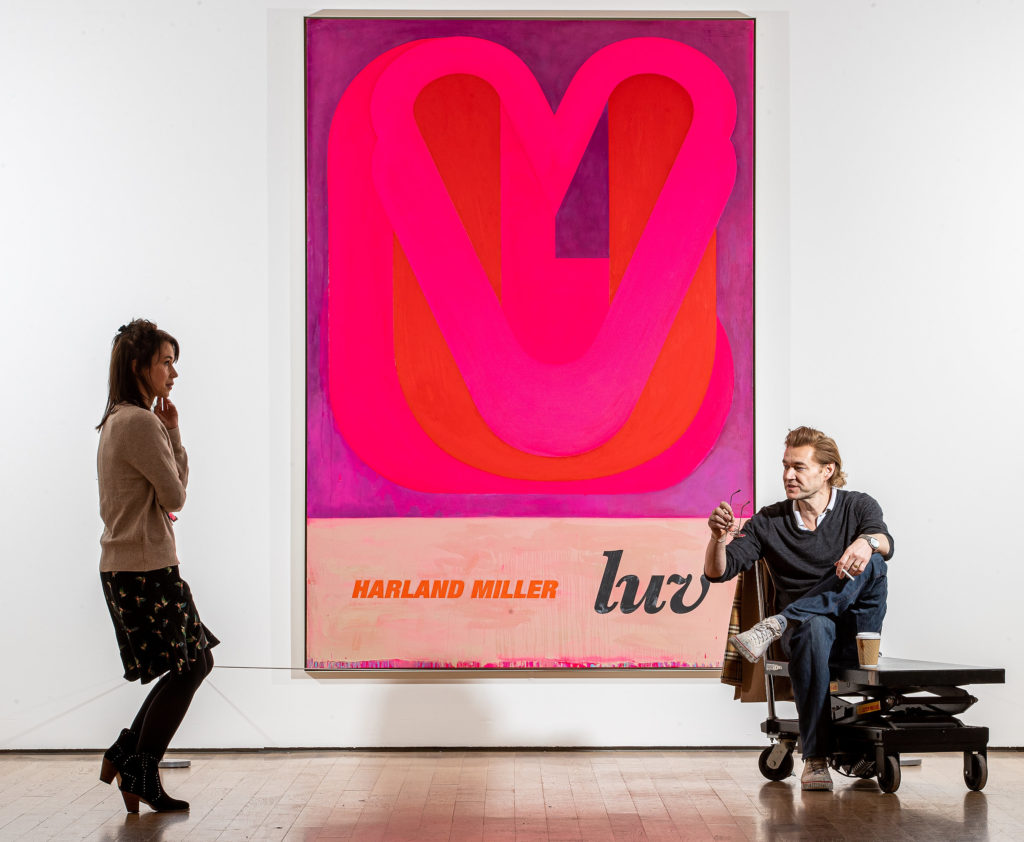
How was this solo show in York curated?
“Though we discussed many approaches and different styles of work to be included, it was obvious to all of us that the show was always going to be hung around the Bad Weather Paintings about Yorkshire towns – and it is!
“This series has been collected internationally, which is just wonderful to think of. Some of them I hadn’t seen since they left the studio. I happen to know, for example, the Bridlington painting is on permanent display in Texas – arid Texas! – so it only seemed right that they at some point should be shown here in York at the York City Art Gallery, the place where I first encountered painting. It’s great to see that painting in York.
“I’m not even going to say it’s a dream come true to show here because, back then, when I was a kid sneaking round the gallery feeling like I didn’t belong, it was actually beyond my wildest dreams to be showing here.
“And I think it’s been curated in that spirit – in the spirit of celebration… but also of the future. Even away from even away from the Bad Weather Paintings, the works we have chosen have been more positive examples of what’s on offer.
“This is ironic, really, as the one place on Earth where the black humour in the work is understood and will not get me misinterpreted is here in Yorkshire, but maybe we’ve second-guessed that.
“Even the Hell paintings are positive, and I think, I hope, the visitor will leave with a kind of an UP feeling.
“In fact UP is one of the letter paintings from the latest series. The name I’ve given the series, Letter Paintings, is a bit flat, I must say, but it literally comes from the illuminated letters that you find in a medieval manuscripts, which seem to need no extra fanfare!
“These letters were painstakingly hand drawn and coloured by the monks, where the first letter of the first word in these manuscripts were always given this highly detailed embellishment. It works as an intensifier really. It gives a fanfare to the page, to the first line.
“When I left school, I happened to be one 0-level short of the five you needed to get into art school and so they asked me if I wanted to come on the course and while there go to night school and take the requisite qualifications to stay on the course.
“I said ‘yes’ and was amazed you could take an A-level in lettering. That was how and when I encountered the monks’ art in detail for the first time. I loved it and actually rendered one of these illuminated letters for my final exam, I recall.
“My background in copying all sorts of heavy metal type fonts on to the backs of denim jackets really stood me in good stead for making a painting on parchment and it gave me a practised hand for rendering lettering too.
“But the best thing was it gave me a life-long appreciation of type faces and the art of hand lettering, For a while, I wanted to be a sign painter: a guy who went around painting those swinging signs you get above pub doorways in the country.
“But the other the thing I wanted to do, in this new series, was to try and convey a story – encapsulate a narrative – but not in an aphorism or maxim but in a single word.
“I wanted to go as far the other way as possible and use just one word, one short word at that, and see if that word would convey as much as a whole sentence.
“I hoped the answer to this would be ‘yes’. In fact that was one of the first words I painted. YES.”
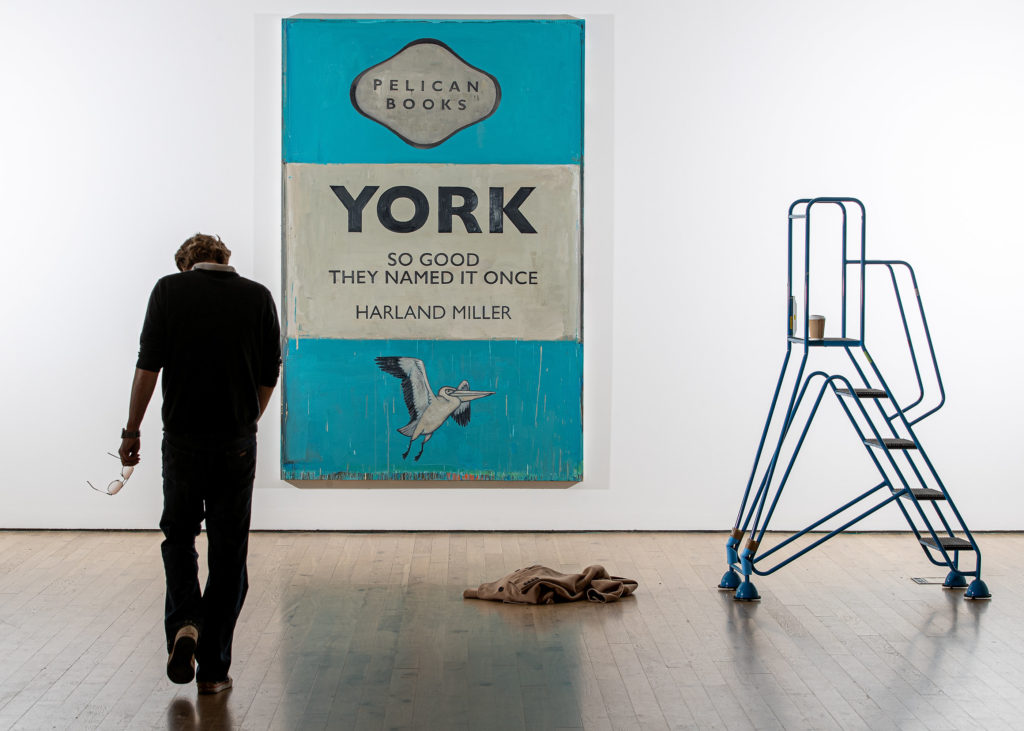
What are you saying about York in that picture title on a retro book cover, York, So Good They Named It Once, now replicated on posters, mugs, key rings, fridge magnets and tote bags?
“People have thought ‘York, So Good They Named It Once’ must be satirical, comparing York to New York, whereas I thought I was riffing on York being first; being very important way before New York – and being a Roman capital too.
“It was also a place of so many firsts for me; where I did my first paper round, and through these streets I can go and remember things that happened to me. Like my first kiss on some old wasteland on Taddy Road [Tadcaster Road], that’s now a Tesco.
“And just round the corner from here, behind the library, I smoked my first joint. That’s why I got hooked on books…because I was by the library!
“This gallery is where I first saw paintings. Is it a dream to be back here? The answer is ‘No’, because, as a boy, it would have been foolish to dream of such a thing.”
What was Penguin’s initial reaction to your York artwork and other Penguin Book Covers?
“I tried to get Penguin to come round to it, but they were talking of suing me. But then in came a new CEO, John Makinson, who was a bit groovier than the previous one!
“The new CEO had received a picture of the York painting, and when Stephen Fry said ‘what nonsense to sue him, we need to back him’, it made an impact, so I have to say thank you to Stephen.
“I thought I was being invited to Penguin to get sued, but it went from that to being invited to lunch and John said, ‘I’d really like to commission something from you’. I was there with my [art] dealer Jay Jopling, from White Cube, and it became a commission for 14 works for their foyers etc.
“It was great not to be sued, but then maybe I felt it lost its edge, but I enjoy doing them so much and I’ve never said I’ll not do another one.”

Why is Blackpool included in your Bad Weather Paintings series when all the others feature Yorkshire places such as Whitby, Scarborough, Bridlington and Sandsend?
“Blackpool is the exception that proves the rule! As a child I just assumed Blackpool was in Yorkshire because we only ever went to Yorkshire!
“What inspired that series is I remember there was a kind of re-branding of Britain going on in the 1980s, and I wondered if it was all being done from London, as it was chronic, and I thought ‘why can’t it be done in-house?’.
“I set about re-branding Yorkshire seaside towns and villages, but to say it wasn’t necessary because they retained their charm and didn’t need a Balearic feel to their branding as it doesn’t suit these towns with all their rain! I remember sheltering under kagools in the 1970s, and that’s what these paintings are a homage to.”
Words first, then imagery?
“Once I’ve decided on the text, then I’ll decide on how to paint them, but once I’m painting, then I lose the sense of what the words say and I’m just making sure it works as a painting.
“In fact, I have a wall of text in my studio that I can’t use because I can’t make the words work graphically.
“But I also know that if people don’t like the words, they won’t like the painting.”
Why do you enjoy playing with words?
“I like how by changing one letter, or one word, you can change the whole meaning, like ‘Have Faith In Cod’ for Scarborough or ‘Something Tells Me Nothing’s Going To Happen Tonight’ for Bridlington.
“When I lost my sister Helen, she requested her ashes be scattered in Scarborough, and the next morning there was a sea fret, and I remember looking out over the sea, and on the sand was written Have Faith In Cod, and when a dog ran through it, it changed it to God. It seemed apt. Helen did have faith in God…and in cod.”

Aside from painting, what else are you working on, Harland?
“I’m writing a memoir at the moment. In fact I’m way behind with it; I’m currently nine years old dreading being ten.
“Some people turn pale when I say I’m writing my memoir, which at first wasn’t an encouraging reaction, but they later explained they thought this was something that one did when one was nearing one’s end, when the doctor has told you to get your affairs in order or, y’know, ‘not buy an LP’.
“But I think it’s not a bad idea to start it around now. I’m 56 and I think I’ve still got really good recall but that could change at any time, and it would be pretty – make that very – frustrating to write a life story if you couldn’t remember any of it. That’s the way my dad went – with the Alzheimer’s. So distressing.
“That’s why it was originally titled I’ll Never Forget What I Can’t Remember, but as I’m chronically superstitious, I’ve changed it to One Bar Electric Memoir.
“When I left home 37 years ago, my mum gave me a one-bar electric heater. It had frayed pre-war wiring and no handle, which made it very hard to carry. She said ‘there was no mad rush to bring it back’. It’s the one thing that’s been everywhere with me and, actually, I’ve still got it. It’s very reassuring.
“I plug it in when I’m writing and, as the filament heats up, it gives off this smell of, well, of a filament heating up, but it takes me right back to a million bedsits, almost more than the reflective dish behind, which gives off this insane orange reflection. It actually does feel like I’m plugging into the past.”

Did you know?
Harland Miller designed the wedding invitation for pop star Ellie Goulding and art dealer Caspar Jopling’s service at York Minster in August 2019. “I’m her favourite artist,” says Harland.
